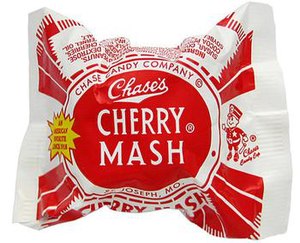KANSAS CITY, Mo. — Missouri is the birthplace of several famous candies, chocolates, and confections. The Cherry Mash is the third-oldest candy bar in the country and is produced in a factory in St. Joseph, Missouri. It can be found throughout the Midwest in most grocery stores. There’s also Askinosie Chocolate out of Springfield; Patric Chocolate in Columbia; and Pixy Stix, Sprees, and SweeTarts all originally out of St. Louis.
Fudge and taffy shops are sprinkled all across the Show Me State from the Uranus Fudge Factory to the shops at Silver Dollar City in Branson. The state has done plenty to set the standard on candy, so if you want to offer a little bit of history to trick-or-treaters this Halloween, here are some interesting tidbits from the state.


Cherry Mash, St. Joseph, MO: It’s an American candy bar with a soft, cherry-flavored center. It has maraschino cherries covered in a mixture of chopped peanuts and chocolate. Ernest Chase came up with the recipe in 1918. He was the son of Dr. George Washington Chase, who went into the candy business in St. Joseph back in 1876. The Cherry Mash was originally called the Cherry Chase. The original candy consisted of a quarter-pound mound of chopped roasted peanuts, blended with chocolate coating over a smooth cherry fondant center.
In 1944, F.S. Yantis and Company purchased Chase Candy for more than $1 million. Today, Cherry Mash is the Chase Candy Company’s best-selling product. It is still produced in St. Joseph. It’s considered the best-selling cherry candy bar in the United States. The bars that were not best sellers for the company included: Real Stuff, Opera Stick, Lulu Bar, Cherry Rummy, Mammy’s Pride, Candy Dogs, and the short lived Mint Barber Pole.
Askinosie Chocolate, Springfield, MO: In 2005 a criminal defense lawyer in Springfield decided to switch careers and open up a chocolate factory. Shawn Askinosie learned everything about chocolate — botanically, historically, and culturally. He wanted to create chocolates people would love. He went around the world to study cocoa, going to the Amazon to meet with farmers and see how post-harvest techniques influence a finished chocolate’s flavor. Now he’s on a mission to change the world one bar at a time. The shop offers a variety of chocolates from peppermint dark, dark chocolate + peanut butter, and dark chocolate + red raspberry.
Patric Chocolate, Columbia, MO: Chocolate maker Alan “Patric” McClure traveled all over Europe after graduating from the University of Missouri with a degree in religious studies. While overseas, he learned proper techniques for baking, chocolate making, and cheese making. France had a profound impact on him; studying there, Patric learned the French chocolate tradition, including Valrhona and Bernachon. When he returned to Columbia in 2006, McClure decided to open up a chocolate company. His company searches the world for the best cocoa beans, and he chooses organic whenever possible. With 21 total Good Food Awards across eight years, this makes Patric Chocolate the all-time winner of more Good Food Awards than any other company nationwide — and across all categories.

Pixy Stix, Sprees, SweeTarts, St. Louis, MO: In the 1900s there were two big places for candy in the Midwest: Chicago and St. Louis. Between 1898 and 1914, candy producers doubled in number within St. Louis city limits. Some of the most well known candies of today were invented by the St. Louis company Sunline Inc. The company eventually changed its name to Sunmark Corporation, with offices in Affton, but later merged with Breaker Connections, who made the original Wonka Bar in the 1970s. That company was later bought by Nestle and in 2006, Nestle shut down the original Sunline/Sunmark offices still located in St. Louis.
Pixy Stix first came into development in 1942. Candy innovator J. Fish Smith found that children were eating the sweet and sour powder straight from a penny drink mix. Smith modified the formula and branded it as Lik-M-Aid. In 1959, the product was packaged in color-striped straws and introduced as what we know today, Pixy Stix. The candy is currently manufactured by Wonka Confections.
SweeTarts were invented in 1962. The candy was created using the same recipe as Pixy Stix, but the candies were meant to be less-messy as parents didn’t really like Pixy Stix. The original flavors were cherry, grape, lemon, lime, and orange.
Spree was an idea by an employee named John Scout. Spree is classified as a compressed dextrose candy, covered in a colored fruit-flavored shell. A chewy version of sprees came out years later.
Switzer’s, St. Louis, MO: Frederick Michael Switzer started selling candy in the 1880s in a pushcart along the Mississippi River near Laclede’s Landing. He was the son of Irish immigrants who left the country during the potato famine. Switzer began making licorice in 1888. Switzer also became famous for producing “buttermels,” a chewy caramel candy.
St. Louis Peco Flake: The candy is a mixture of peanut brittle and coconut. It was not invented in St. Louis, but popularized there at the General Candy Company, located on Oleatha Avenue. The company’s founder sold peco flake candy to the Cub Scouts in 1959. It rose to fame across the country because of its connection with the national organization.


Valomilk, Kansas City, MO: The candy was invented by accident in 1931 in the Kansas City area when a worker added too much vanilla to a batch of marshmallows. The creation was later dipped into milk chocolate. It is manufactured by Russell Sifers Candy Company in Merriam, Kansas. Sifers was located in Kansas City in 1931. Valomilk represents three ingredients: vanilla, marshmallow, and milk chocolate. Valomilks are currently the only candy still made by the Sifers company. It discontinued its general product lines in the 1950s.
Waffle Cones, St. Louis, MO: Not candy, but waffle cones had its start in St. Louis. The first cones came about during the 1904 World’s Fair. The vendor, Ernest Hamwi was selling a waffle-like pastry called zalabis at his booth. He noticed a neighboring booth selling ice cream, but the vendor had run out of bowls. Hamwi then rolled his waffles into cones, stuffed them each with a scoop of ice cream, and solved the bowl shortage problem. At least, that’s how the legend goes.
Russell Stover, Kansas City, MO: It started out as the world’s first chocolate dipped ice cream bar. Stovers’ wife Clara said it should be called an Eskimo Pie. The company actually got its start in Denver in 1923. Nine years later, the company moved operations to Kansas City. It was owned by the Ward family until July 14, 2014, when the Swiss chocolate maker Lindt bought Russell Stover Candies.
Bogdon Reception Sticks, Kansas City, MO: Walter Bogdon created the chocolate-covered candy sticks for a bride in 1945. Bogdon was a Polish native who worked in Kansas City in the candy department at Loose Wiles Biscuit Company. He started his own candy business in Joplin, Missouri before moving to Fairway, Kansas at the end of World War II. In the present, Bogdon Candy Co. Inc. is a subsidiary of Richardson Brands Company and its products are available online.

Cotton Candy, St. Louis, MO: The confection is mostly sugar, with small amounts of flavoring or food coloring added. Dentist William Morrison and confectioner John C. Wharton invented cotton candy. It was machine-spun in 1897. It was first introduced to a wide audience at the 1904 World’s Fair in St. Louis as “Fairy Floss.”
Mavrakos Candy, St. Louis, MO: A Greek immigrant brought his treasured family recipes to St. Louis in the early 1900s. John L. Mavrakos opened up a candy and ice cream shop at Vandeventer Avenue and Oliver Street in 1904. During the company’s peak in the 1950s, Mavrakos had over 16 retail stores in the St. Louis area. Mavrakos sourced only the finest cocoa beans for its creamy milk and dark chocolate. One of its most popular items was a slab of milk or dark chocolate. Some of the most cherished chocolates today stem from the original Mavrakos recipe book. Some of those recipes include: Pecan Burrsâ, Molasses Puffs, Heavenly Hash (now called Pecan Marshmallow Bars), Coconut Crescents, fondant Bon Bon Creams, and Marshmallow Eggs.
